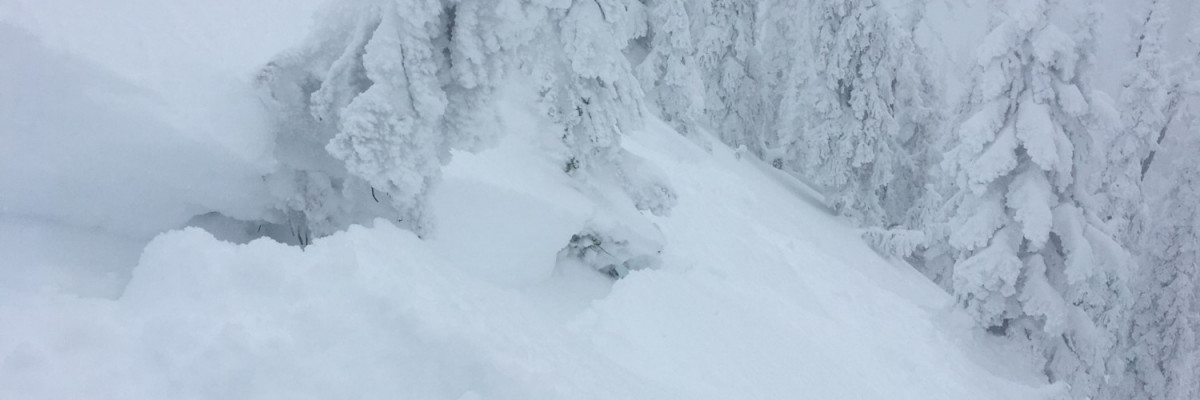Today’s avalanche danger is rated CONSIDERABLE on wind loaded slopes and MODERATE on all other slopes in the southern Bitterroot. Avalanche danger is MODERATE on wind loaded slopes and LOW on all other slopes in the Central Bitterroot, Rattlesnake, and Seeley Lake areas.
Good morning, this is Andrew Schauer with the West Central Montana avalanche advisory for Saturday, February 15, 2020. Today’s advisory is sponsored by LB Snow. This advisory does not apply to operating ski areas, expires at midnight tonight, and is the sole responsibility of the U.S. Forest Service.
Weather and Snowpack
After a brief break in the action, the faucet is turning back on throughout our advisory area. In the last 24 hours, we received 4-8 inches of new snow in the Bitterroot, with a trace to 2 inches in the Rattlesnake and Seeley Lake areas. This morning, winds are blowing 10-20 mph out of the west and southwest, and mountain temperatures are in the low 20’s. Today we can expect to see 2-4 inches of new snow, with slightly higher totals in the Seeley Lake area. Mountain temperatures will get into the high 20’s to low 30’s and winds will be 15-25 mph out of the west with gusts reaching 50 mph. Snow will pick up this afternoon through tomorrow, and we will see 6-10″ of new snow by tomorrow morning, with higher totals at higher elevations.
As the storm unfolds, our primary concern will be triggering fresh wind slabs, which can be found on steep, wind-loaded slopes. These avalanches can be up to 3’ deep, and will be big enough to bury a person (video, photo, photo). The best way to manage a wind slab problem is to avoid steep, wind-loaded terrain. You can recognize a fresh wind slab by sticking your pole in the snow, or hopping off your sled to look for dense snow that is deeper than the storm totals in the area. Cornices and wind-affected surfaces are also good indicators of unstable wind slabs. A wind slab will be easy to identify in a snow pit, and it will be likely to propagate in a stability test. You do not need to dig deep to identify this problem since it will only exist in the upper 2-3 feet of the snowpack.
With more snow stacking up, we will also be dealing with a storm slab problem. Storm slabs will be up to a foot deep, and can be recognized by looking for shooting cracks or recent avalanche activity. While these avalanches may not always be large, they can still be dangerous in consequential terrain. If a storm slab is reactive, it will be possible to identify the problem by doing a quick stability test.
Jeff was in the southern Bitterroot yesterday, and he found weak, faceted snow near the ground that was still failing in stability tests. This layer is not present in the rest of our advisory area. It has now been one week since the last reported avalanche that failed on this weak layer (photo), and it is becoming less likely to trigger an avalanche deeper in the snowpack. However, new snow and moderate winds will apply a load that will push this weak layer closer to its breaking point. Translation: we have a deep persistent slab problem in the Southern Bitterroot. Before committing to steep terrain, take the time to dig a pit and look for that weak, sugary snow near the ground. Keep in mind these deep weak layers will not always fail in stability tests, and you might not see any red flags like collapsing or shooting cracks before triggering a large avalanche. If you notice poor structure, stick to slopes less than 30 degrees that are not connected to steeper terrain. Avoid slopes that have been previously scoured, areas with rocks poking out of the snow, and slopes that have avalanched earlier this season.
The Bottom Line
With more snow and wind in the forecast today, it is important to take the time to dig a pit and do a quick test before committing to avalanche terrain. Stick to slopes that have not been recently wind loaded, and keep an eye out for red flags like recent avalanches, shooting cracks, and collapsing in the snowpack. If you are planning on getting out in the Southern Bitterroot, be sure identify and avoid slopes with weak, sugary snow deep in the snowpack.
Your observations are extremely helpful! If you get out, please take a minute to fill out the observation form on our website (missoulaavalanche.org), or shoot us a quick email at [email protected].
We offer a variety of avalanche courses throughout the winter. Our education calendar is posted on our website. We will be running two avalanche awareness lectures at Lost Trail this Sunday, Feb 16 (details).
























